If the Internet is turned off, how does the blockchain survive?
Source: Chain smell
Written by: Pan Zhixiong
Blockchain technology, especially the bitcoin-led cryptocurrency, has a core feature of " decentralization, " which avoids problems caused by single-node failures.
However, basically all transaction information and ledger data in all bitcoin networks are now transmitted via the " Internet Internet ", which means that to pass the Internet Service Provider (ISP) , it means that the ISP can block or Monitor certain websites and services that users visit. A similar example is, for example, in the United States, using the peer-to-peer download tool BitTorrent to download certain pirated resources, it is possible to receive warning letters from ISPs and copyright owners.
- How does the blockchain drive the decentralized network and count those blockchain projects that fit into Web 3.0?
- Dark Net Silk Road drug dealer pleaded guilty about this dark world, how much do you know?
- How far are we from the real DAO?
Some teams have been experimenting with changing the status quo. For example, Bitcoin technology development company Blockstream is trying to synchronize bitcoin block data to space via satellite, so that users can use the signal receiver to access the bitcoin network in the satellite coverage area, even if their own network cable is broken. In addition, Nick Szabo, the father of smart contracts, and his colleague Elaine Ou proposed a plan to use bitcoin to transfer money by radio in 2017. Later, co-founder Rodolfo Novak and OpenBazaar, co-founder of hardware wallet developer CoinKite . Sam Patterson successfully completed the bitcoin transfer using radio communication.
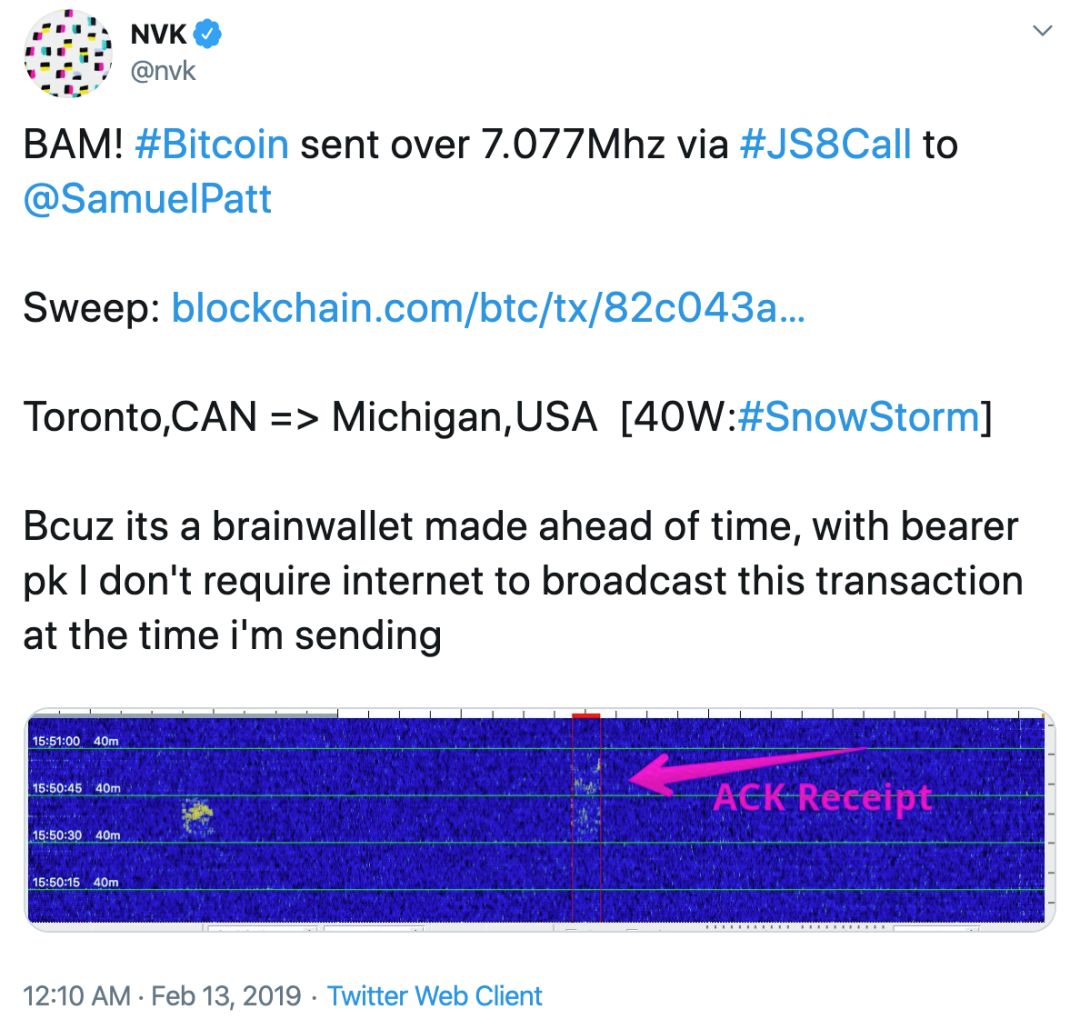
In February 2019, Rodolfo Novak and Sam Patterson announced the use of radio communications to complete bitcoin transfers.
Rodolfo Novak also used the radiocommunication to complete the transfer of the Bitcoin Lightning Network – using radio transmissions not only avoids the centralized service of the ISP, but it can also be faster and closer to the speed of light than by fiber or broadband.
In addition, there are some projects that attempt to build a " mesh network Mesh " technology that can implement "peer-to-peer network" or higher in a physical environment independent of the Internet, and solve specific network transmission problems in specific scenarios. These products are inextricably linked to the "decentralization" concept of the blockchain and evolve together.
This article hopes to introduce three of the iconic projects: Open Garden , goTenna, and Helium , as well as Apple 's practical applications in this area.
This is a technical direction worthy of attention. Nick Szabo, the father of smart contracts, once commented on Blockstream's satellite project: "I hope this will be a trend: the global technology of blockchain can finally be transmitted using real radio broadcasts instead of using the Internet. This will bypass the Internet bottleneck."
From a certain point of view, when a distributed network can survive without the Internet, it can truly achieve decentralization.
The Open Garden project began in California in 2011 with a number of adjustments to its business and product line priorities. Open Garden attempts to establish a peer-to-peer network in a physical environment through Bluetooth and Wi-Fi on devices such as mobile phones.
A typical application case is that in a company's office, when everyone's devices are running Open Garden software, each device will be connected or relayed via Bluetooth or Wi-Fi, that is, device A passes. Device B is connected to device C, so this can also be called a "mesh network." If the device accessing the mesh network, some devices (such as mobile phones) cannot access the Internet, and some devices (such as PCs) can access the Internet, the physical mesh network can access the network. The ability of the Internet to share: The mobile phone Bluetooth is connected to the PC after jumping through several devices, thus gaining Internet access.
This may pose a problem, and users may not necessarily be willing to share their Internet access capabilities. Therefore, Open Garden also officially launched a token incentive mechanism with blockchain characteristics in April this year. Nodes sharing Internet access capabilities can earn "OG" tokens priced by nodes, while devices using node traffic data need to be used. Pay the corresponding "OG" token.
Nodes that currently earn OG tokens need to use Open Garden's dedicated Wi-Fi sharing device for $30.
Interestingly, the token OG was issued through the Stellar Agreement and is now only available for trading on Stellar's decentralized exchange. OG has not been included in any market website, and it is quite unpopular and low-key for a project over 8 years.
FireChat is a chat tool released by Open Garden specifically for "no internet" status. The underlying technology is similar to Open Garden, which establishes a mesh network in a physical environment via Bluetooth and Wi-Fi to accomplish the special function of "chat".
For example, suppose a natural disaster occurs in a certain place, causing all network connections to be cut off. At this time, WeChat or any centralized service cannot be used. Although it is also possible to use a satellite phone to access the network, the cost is not ordinary users. Burden. If everyone installs FireChat and runs it at this time, each device is a node that sends and receives data. Each participant can invisibly increase the coverage and robustness of the entire Mesh network, and finally achieve a networkless environment. Chat.
In the introduction of the FireChat official website, some specific application scenarios are also mentioned, such as network blockade, crowded music festivals, crowded places, etc., which are ideal scenarios for the application.
In a 2014 media report, Iraqi users began looking for alternatives to communication tools due to large-scale network blockades and surveillance in Iraq. Because FireChat does not require the Internet connection feature, it has gained a lot of users. The article also mentioned that the encryption and security measures of FireChat at the time were not perfect, so there may be security risks. But now FireChat already includes end-to-end encryption.
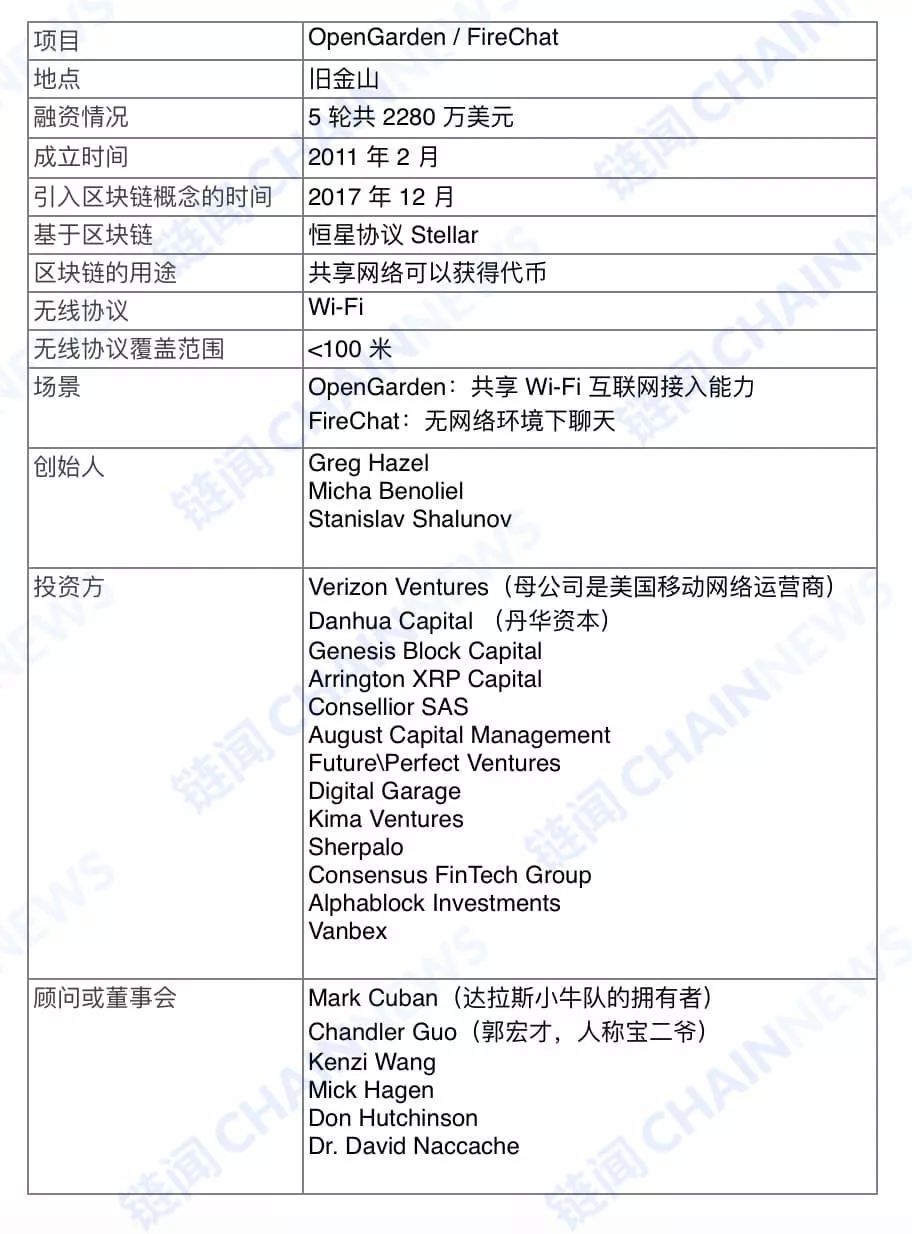
Basic information on Open Garden and FireChat, Pan Zhixiong finishing
goTenna, txTenna and Lot49
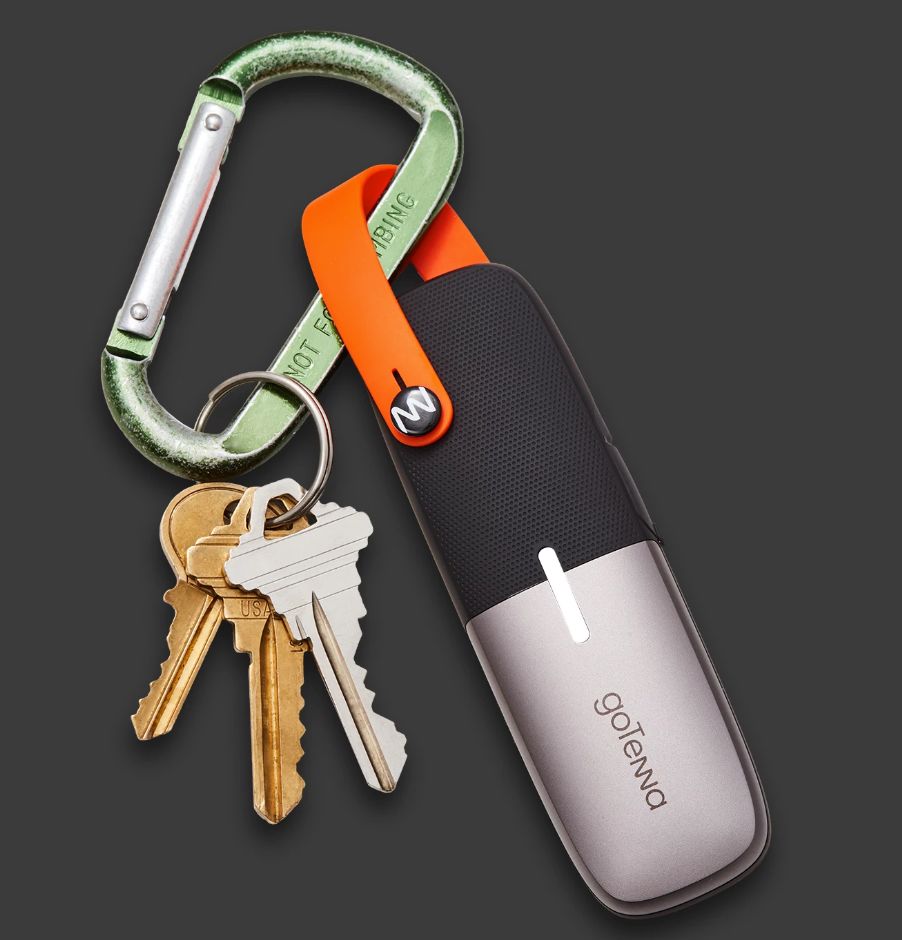
In order to improve the transmission distance of the Mesh network, goTenna uses its own wireless transmission scheme. The transmission distance in the open area can exceed 6 kilometers, and the city can reach 1 km. After the phone is connected via Bluetooth and goTenna, goTenna allows users in its built-in mesh network to send 1-to-1 messages, group messages or shared geographic locations without the Internet.
GoTenna's product positioning is very different from that of Open Garden. It is more suitable for scenes with larger transmission distances. The official scenes include outdoor tourism, international travel, emergency communication, music festivals or carnival crowds.
txTenna is a special use scenario for goTenna Mesh: Broadcasting bitcoin transfer data without a network. This complete solution consists of four parties: users, txTenna (and goTenna Mesh) , Samourai Wallet and Blockstream satellites.
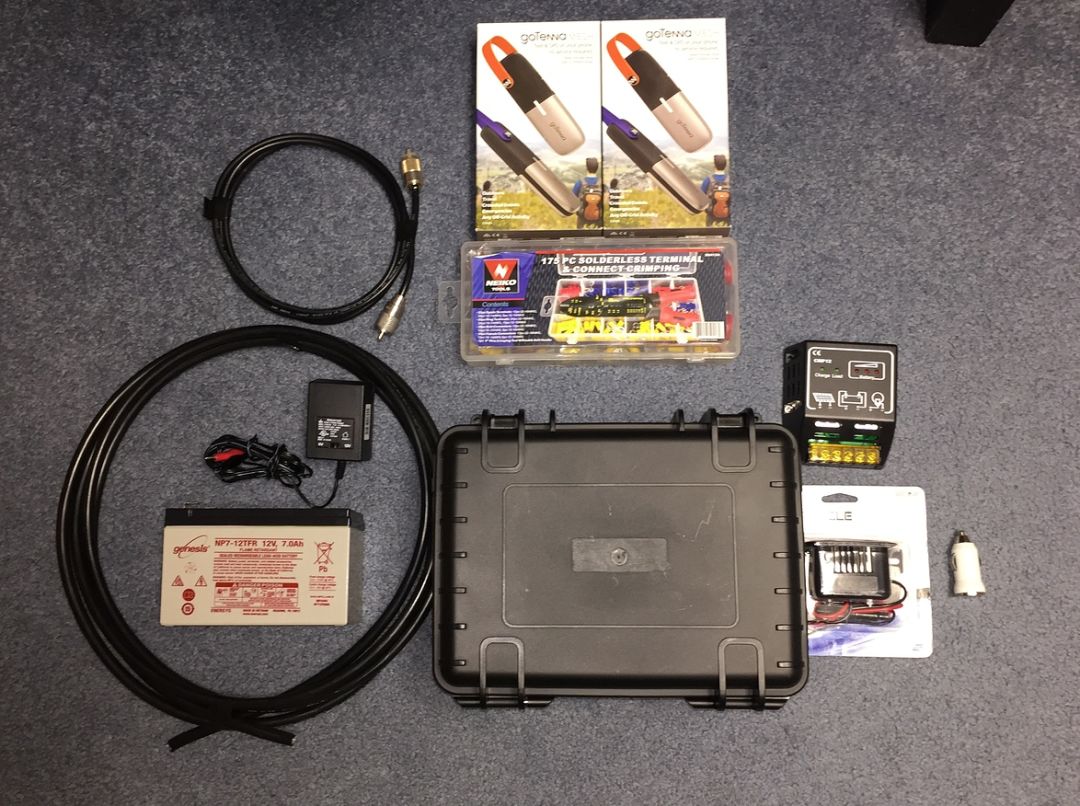
Suppose a user has no Wi-Fi and mobile signals nearby and cannot access the Internet. The user's request is to send their own bitcoin transfer request data to the Bitcoin network. The user can do the following:
- You need to use the Samouai Wallet to initiate a transfer request. The Samurai Wallet is an open source bitcoin wallet with privacy features on the Android platform. GoTenna has said that it will support more wallets in the future.
- The user uses the samurai wallet to sign the bitcoin transfer data and send it to the txTenna App.
- txTenna sends the data of the signed bitcoin transfer request of the Samurai wallet to goTenna Mesh via Bluetooth.
- goTenna Mesh broadcasts the data to other devices in the Mesh network consisting of goTenna Mesh. As long as txTenna in one device has Internet access capability, the transfer data can be broadcast to the Bitcoin network. The computer can also access the mesh network via goTenna Mesh and then synchronize the transfer data to the Bitcoin network via the txTenna-python script. There is currently a limitation in this scheme, and the node that must initiate the transfer request needs to send data to the networked node within 3 jumps.
- The Blockstream satellite is an optional part. If there is a node in the Mesh network and a satellite data receiver (a device that looks like a "pot") , then the Mesh network can obtain full bitcoin block data in the disconnected state. Because the receiver that receives the BlockStream satellite signal can download all the bitcoin nodes on the Blockstream satellite to the local, this is itself a solution for obtaining full bitcoin data in the state of Internet disconnection.
Recently, goTenna released a white paper called " R Lot49 ", which innovatively uses the micropayment function of Bitcoin's Lightning Network as an incentive system for building physical Mesh networks, creating a true decentralization that can be separated from ISPs. Robust communication network.
A mesh network like goTenna Mesh has a big problem, how to motivate nodes to stay open. Keeping nodes open can improve network coverage and robustness. Lot49 adds the small payment function of Bitcoin Lightning Network to the Mesh network, and as the Relay Nodes, you can get the corresponding incentives when you help to transfer data. Since the bandwidth is occupied, the join payment function does not affect the entire mesh network.
After the Mesh network is built, these relay nodes can send the data to the target user multiple times after the user relays the data. However, due to the throughput and hardware performance of the current goTenna Mesh network, the main usage scenarios are only low-bandwidth data such as sending message data.
Due to the implementation of this protocol, the Schönr Signature Schnorr signature and the BIP-118 proposal need to be deployed based on the Bitcoin main network, so the agreement is still in its early stages.
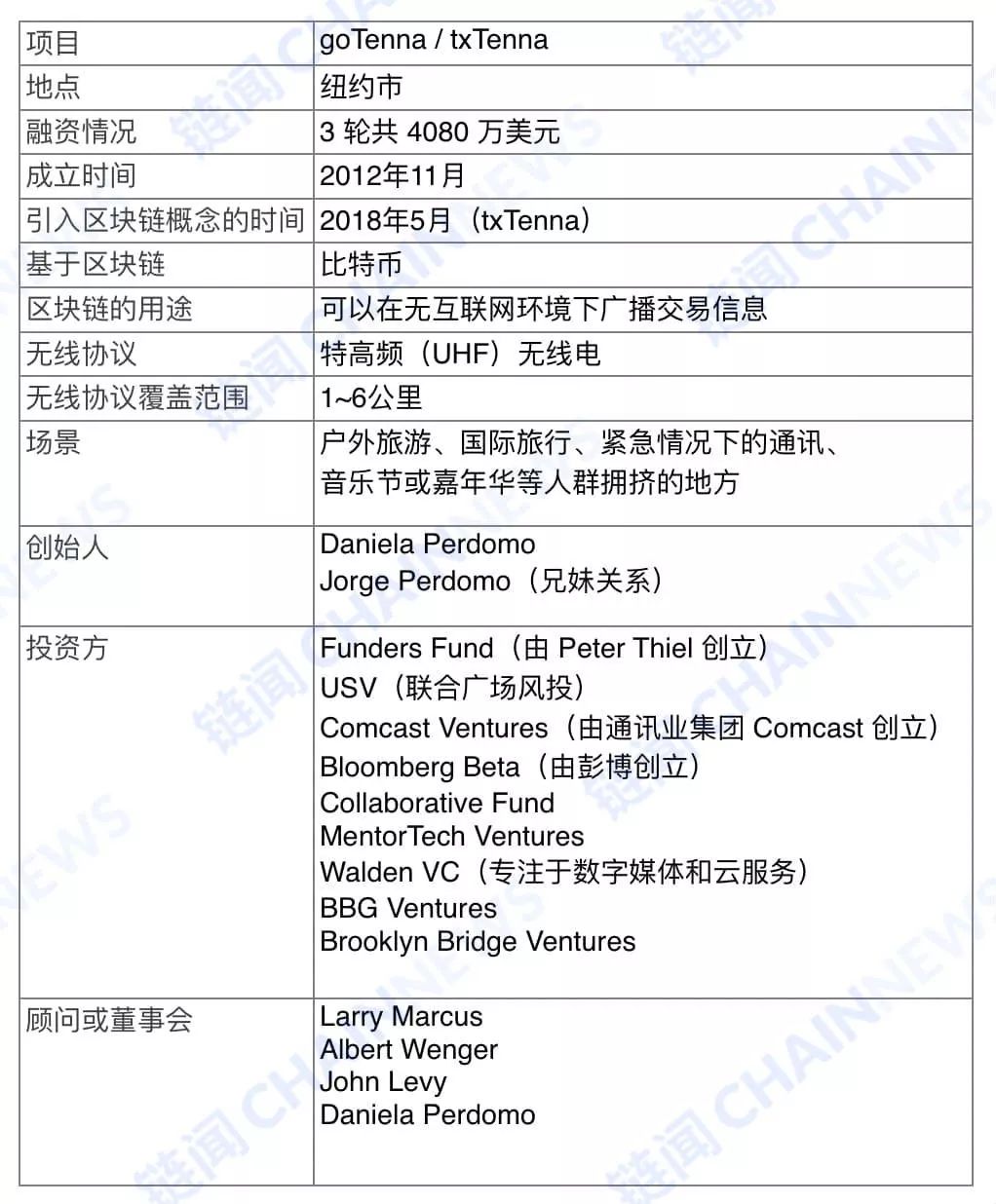
goTenna and txTenna basic information, Pan Zhixiong finishing
Helium
Helium is a hot project recently, with a total of $15 million in financing from Multicoin and Union Square Ventures (USV) in June. Multicoin said the Helium project is their largest private investment to date and is expected to continue investing in this ecosystem for years to come.
One of its founders, Shawn Fanning, is already worthy of attention. The post-80s entrepreneur, programmer, and angel investor made a product written in the history of the Internet and music in 1999: Napster , which is known as the first eDonkey2000. A peer-to-peer network, and nearly 80 million registered users in that era – remember that there were more than 300 million users accessing the Internet worldwide.

Shawn Fanning, one of the founders of Helium
Napster's function is to share pirated MP3 music, which has caused a lot of copyright issues. Since the peer-to-peer network at that time still needed to centralize the server, it was forced to close by the court in July 2001. Although Napster was acquired and retained the brand, it did not continue to be brilliant.
After that, Shawn Fanning also had several entrepreneurships, including the social path of private friends who used to be a big fan, but eventually stopped in 2018.
In fact, as early as 2013, Shawn Fanning co-founded Helium with the other two. At that time, the word blockchain was just born, so this project has nothing to do with the blockchain.
At the beginning, Helium tried to do the Internet of Things field, providing various sensor technologies and even medical institutions. After the transformation, it was added to the IoT platform in the second half of 2018 to add blockchain and mining concepts. , that is, the product of Helium now.
In a word, Helium is a blockchain driven by proprietary hardware devices to provide a peer-to-peer network for IoT device networking.
Helium tried to build an IoT network through the blockchain network as an incentive layer and a decentralized infrastructure. Therefore, the main scene of the project is mainly Internet of Things (IoT), including: forest fire detection, pet location tracking, bicycle anti-theft, agriculture and so on. TechCrunch, a former tech media, also reported that Helium will work with Lime (shared cycling and skateboarding services) to test and try to solve the problem of bicycle and skateboard theft.
In fact, in the field of Internet of Things, the commonly used communication protocols are ZigBee, Bluetooth or Wi-Fi, and their problem is that the transmission distance is limited, and each household may need a dedicated transceiver. So Helium uses proprietary hardware and a proprietary wireless transmission protocol to solve the problem of signal coverage. This dedicated hardware is produced by Helium and is called Hotspot .
Hotspot
In fact, Hotspot can be understood as a mining machine of Helium network, but this mining machine does not consume computing resources to mine. IoT devices can access the Internet through Hotspot, and because Hotspot provides the regional coverage of such wireless transmissions, this form of mining is used to encourage tokens to the Hotspot holders.
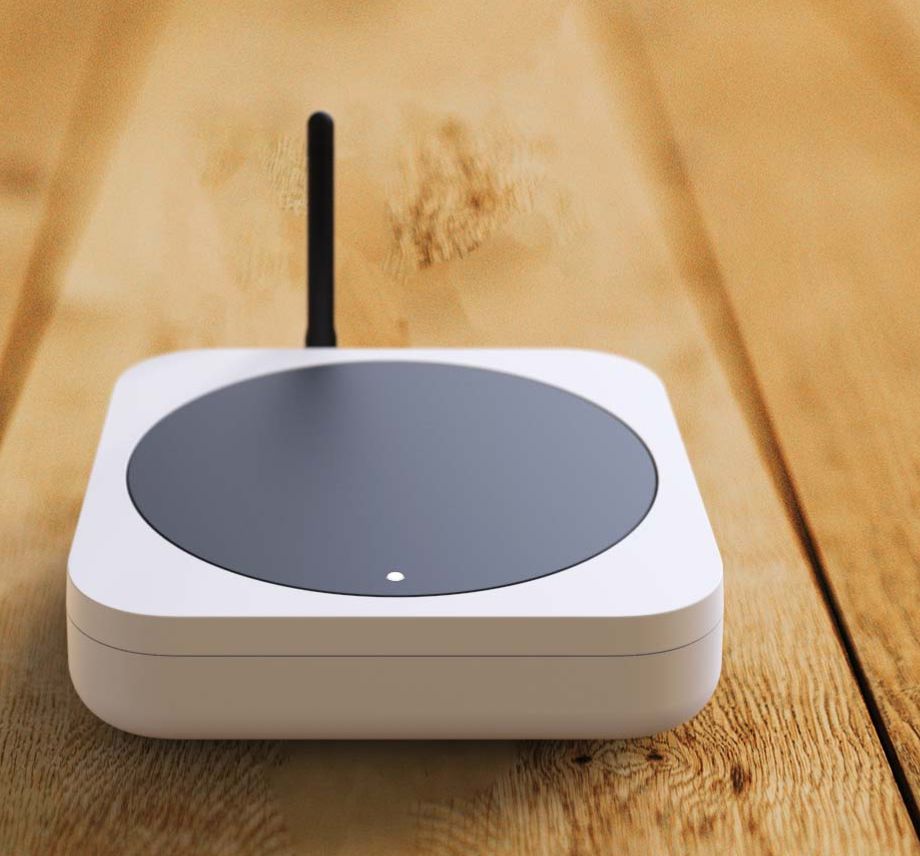
In the wireless transmission protocol, in order to improve the coverage of a single device, Hotspot uses a wireless transmission protocol other than Wi-Fi, but LongFi , which is an open source protocol operating in the lower than 1 GHz band, which is the normal Wi-Fi transmission distance. 200 times and a low frequency band means that these radio waves can easily pass through concrete walls and floors, while requiring one thousandth of the power of a cellular modem (usually used on mobile phones) .
A Hotspot can reach a few square kilometers of coverage, which means that as long as 50 to 150 units can cover the entire city. Hotspot also consumes very little power, with an average operating power of 12 watts, which is the power consumption of a typical LED bulb, which is less than 0.3 kWh per day.
Behind Hotspot is the Helium blockchain, so there will be tokens and consensus mechanisms.
Helium uses a dual token mechanism, one called Helium , to reward Hoptspot for block verification and wireless network coverage. The other is called Data Credits . All data transfer or block transfer fees are paid in this currency, and this token is generated by converting Helium, can't be traded, and is bound to a single user. The Helium blockchain is not pre-excavated, releasing approximately 50,000 Helium tokens per month, prorated to Helium officials and investors (35%) , Hotspot infrastructure (35%) and data transmission (30%) .
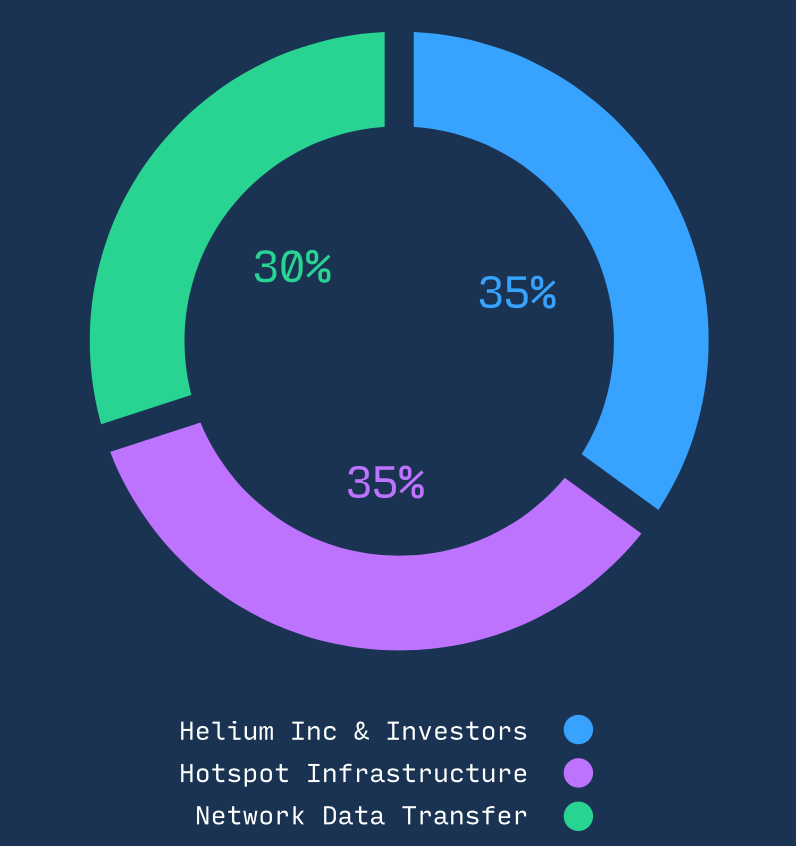
- "Challenger" can allocate 1% of tokens, and the network will select random Hotspot nodes to verify coverage;
- Proof-of-Coverage, which allocates 19% of tokens, when each Hotspot verifies adjacent Hotspot coverage, and depends on the frequency of direct participation in the PoC;
- "Witnesses" can allocate 9% of tokens. After becoming a witness node, you need to monitor and report the PoC, so you can get token rewards;
- "Data Transfer", which can allocate 30% of tokens, according to the amount of data transmitted by the node;
- The Consensus Group can allocate 6% of tokens. All nodes will be ranked as members of the consensus group according to the PoC's situation. The team members will verify the transaction data and package them into districts for the entire Helium blockchain. Distribute after the block.

In general, the economic model is that Hotspot hardware is responsible for connecting IoT devices, implementing LongFi transmission protocols, enabling low-energy, low-bandwidth, high-coverage networks; Helium blockchain is responsible for the implementation of incentives and data layers, through appropriate economic models and The consensus mechanism increases the number and reliability of network nodes. The combination of the two is Helium's layout of the Internet of Things ecosystem.
Multicoin Capital believes that although the Helium network starts with LongFi, such a deployment can also serve as a blueprint for Helium's development of other wireless network types (LTE, 5G, etc.) , enabling Helium networks to generate large telecom network operations in the IoT space via LongFi. The advantage of asymmetrical competition will also push the Helium network into a higher market and compete on higher bandwidth products.
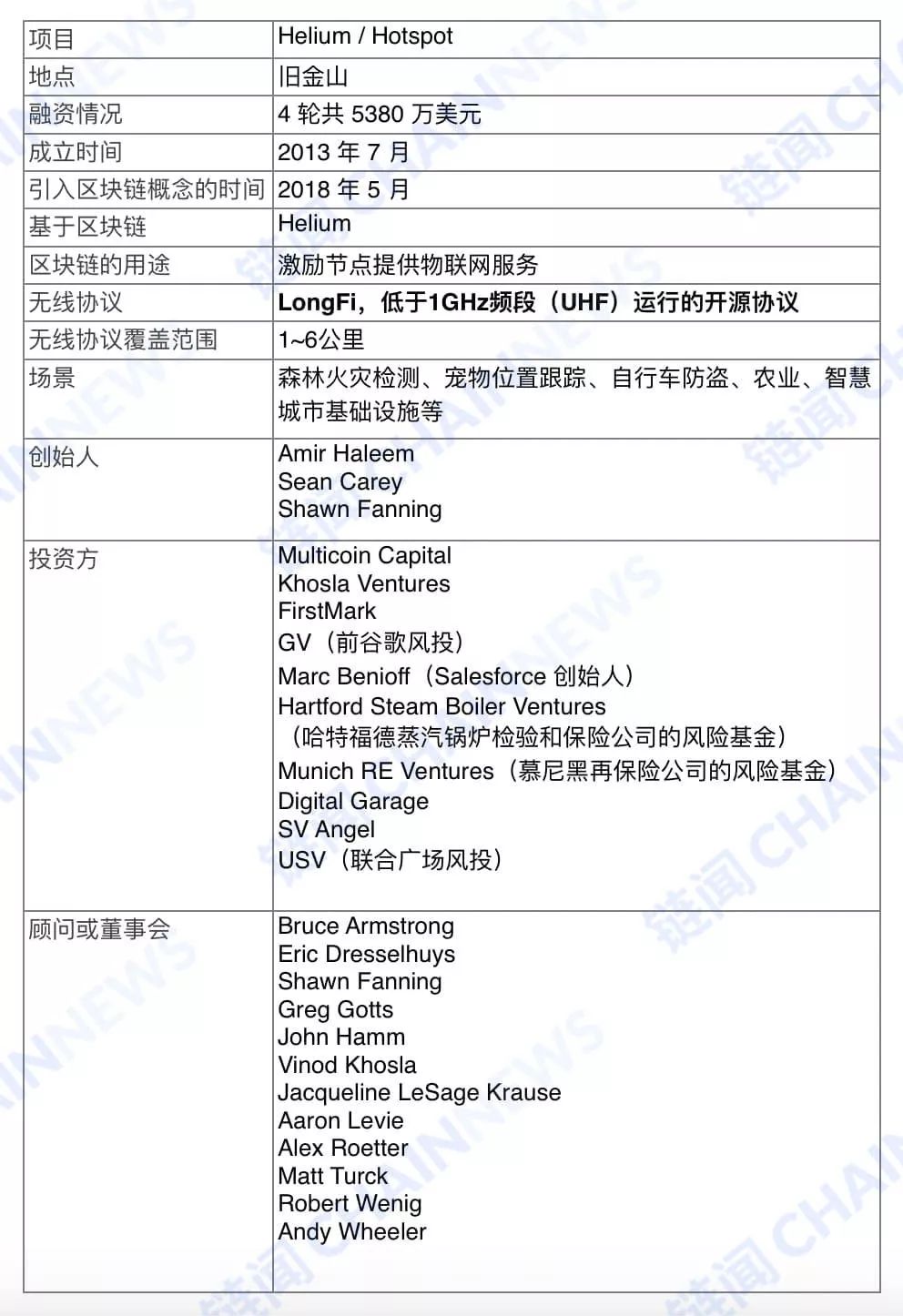
Basic information of Helium and Hotspot, Pan Zhixiong finishing
Recently, the Helium project also released a beta version of the Developer Suite SDK, which explains the LongFi protocol. The SDK is open source and hosted on GitHub, providing developer documentation and sample code, and telling users how to set up their own Hotspot device.
Will Apple's "Find My" be the outpost of the distributed network?
In the Apple Worldwide Developers Conference (WWDC) in June this year, Apple also integrated and released a new service, trying to use the Bluetooth network in the physical environment in the security field. Although this service is not yet a distributed network, it may become a special form of distributed network in the future development.
In fact, long ago, Apple has provided the data security solution " Find my iPhone " after the phone was stolen. After the user's mobile phone is stolen, the user can log in to the iCloud service, then lock the iPhone, erase the data or even track the location, as long as the phone is connected to the Internet again. Moreover, the thief can't restore the phone to the factory settings by any software means, unless the iCloud account and password are obtained, so it also causes the user to often receive the phishing message and the mail may be stolen after the phone is stolen. At the same time, Apple also has a " find friends " service, which provides a scene similar to a group of friends who need to share geographical locations with each other, or a scene where family members share geographical locations for a long time.
In fact, the above two services are based on the integration of mobile network, Wi-Fi and GPS positioning technologies. This year, Apple not only merged the two services of "find my iPhone" and "find friends", but also added third-party Bluetooth as a "relay" to provide a more complete geographical location service and simplified the name as " Find My ".
How to achieve it specifically? Take the MacBook laptop as an example, assuming the computer is stolen or lost. Even if this computer is turned off, it will periodically send out encrypted Bluetooth signals, and the Bluetooth signal data is extremely power-saving, so it can last for a long time. Any iPhone will become a relay device. When only one iPhone in the vicinity scans the encrypted signal, it will upload the encrypted data packet containing the geographic location to the Apple server. Apple can't decrypt the packet, only the lost one can unlock the key of the packet, and then get the specific location.
The technical details of how to do this are security and privacy Wired has been explained in this article: https://www.wired.com/story/apple-find-my-cryptography-bluetooth/ .
Of course, this service can be understood as just a Bluetooth-based and geographically-based application scenario, but with Apple's nearly 1 billion active iPhone users, the service may be a simple attempt. Imagine that only one other device can support the Bluetooth signal. The future development direction may be to support multiple devices to pick up the Bluetooth signal triangle positioning, or use multiple Bluetooth connections between multiple iPhones to provide a more accurate geographical location, etc. After all, the density of iPhone devices in the real environment is far more than that of goTenna, and Apple has already prepared the infrastructure of wireless peer-to-peer networks very early, so this kind of scene can be realized by Apple's unified and closed system. .
Coincidentally, Apple has also imagined the realization of such products as goTenna through the iPhone, which was recently released by the US media The Information .
Apple has a project code-named OGRS that uses Intel chips to send and receive radio waves at 900 MHz (close to the frequencies used by goTenna and Helium) , allowing mobile phones to be on cellular networks (2G, In the scene covered by 3G, 4G, and 5G) , it is also possible to communicate with other mobile phones that are close to each other by radio waves. The report said that the development of this feature has been stopped, but it is likely to appear on future iPhones.
The ultra-wideband UWB and U1 chips in the iPhone 11 series released in September may be a continuation of this technology, which enables indoor positioning and location awareness, but Apple has not provided more details at this stage. Perhaps it is a technical reserve related to AR/VR, or it may be a communication protocol that can be widely used.
So, if one day the iPhone can form a distributed network like Helium and goTenna, it's no surprise.
- One is the non-profit project NYC Mesh , which is trying to build a wireless mesh network in New York City to provide cheaper Internet services, and Mozilla has also donated the project;
- The second one is RightMesh . The project has been developed for 5 years. Although the vision is huge and I hope to provide network services to users who have not yet access the Internet, it is still slow to be questioned by users, and even their technology development has undergone reconstruction and Reorganization
- There is also the Locha Mesh project, an open source project from Venezuela that allows users to send and conduct private information and payment functions without an Internet connection. Two hardware prototypes have been developed and user-built. After the mesh network is out, the Internet access capability can be shared.
In addition to Helium, goTenna and OpenGarden joined the blockchain-related technologies and incentives several years after the project, trying to establish a network transport infrastructure that can be decentralized in the physical environment.
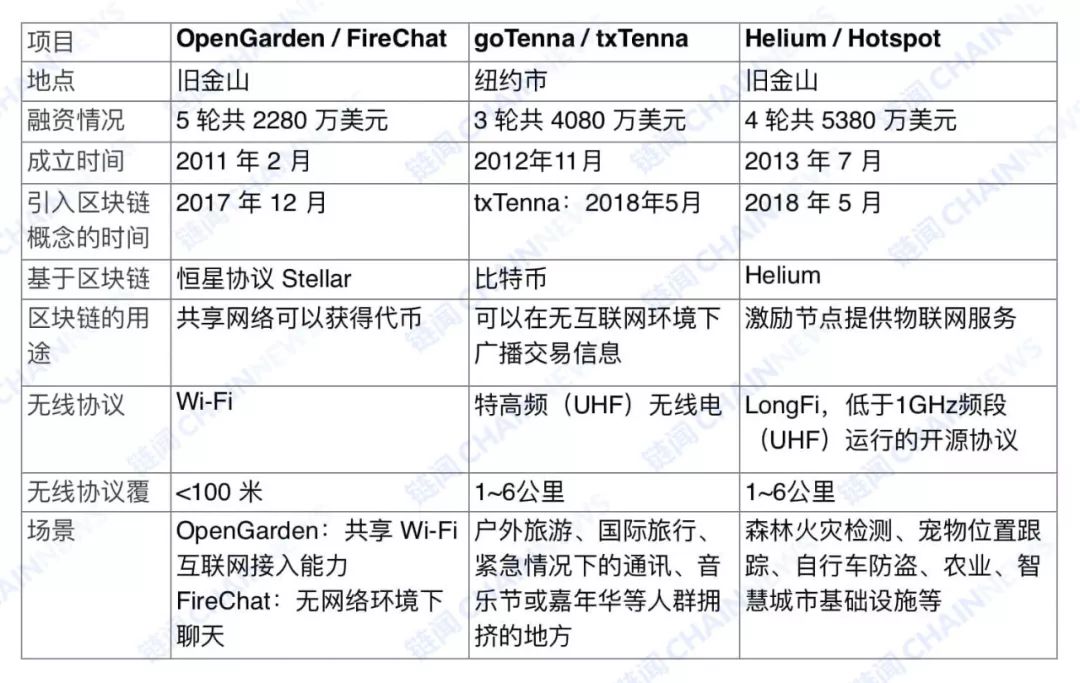
Comparison of basic data of OpenGarden, goTenna and Helium, Pan Zhixiong finishing
This may be because the blockchain concept can help project marketing and financing, or it may be really because the blockchain is the best partner for distributed network, mesh network, decentralized network, and IoT technology. .
- About Apple: [https://www.wired.com/story/apple-find-my-cryptography-bluetooth/]
- iPhone sales for each year: [https://www.statista.com/statistics/276306/global-apple-iphone-sales-since-fiscal-year-2007/]
- [http://whitepaper.helium.com]
- Iraq case: [https://threatpost.com/research-shows-increase-in-internet-filtering-and-usage-of-firechat-app-in-iraq/107402/]
- Number of users in the global access network: [https://www.internetworldstats.com/pr/edi008.htm]
- goTenna Equipment sales: [https://www.coindesk.com/gotenna-bitcoin-wallet-mesh-network
- Lot49 White Paper: [https://global-mesh-labs.gitbook.io/lot49/]
We will continue to update Blocking; if you have any questions or suggestions, please contact us!
Was this article helpful?
93 out of 132 found this helpful
Related articles
- From the arguments of NGC Zhu Weiyu and Dovey, talk about Cosmos
- How to measure the value of Token from the cost?
- IOTA co-founder announces retreat and clears all cryptocurrencies
- The People's Liberation Army newspaper article: blockchain boosts military management
- Cosmos's story: How to "turn" $17 million into $104 million
- QKL123 market analysis | EOS network continues to congest, the fundamentals further deteriorated (1112)
- Beijing will build a “data blockchain” and introduce secure computing to ensure big data security





